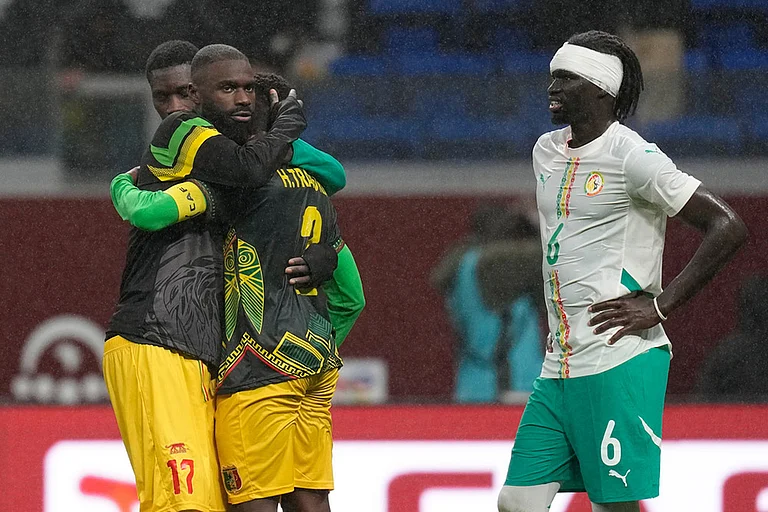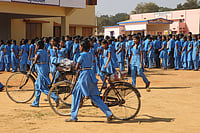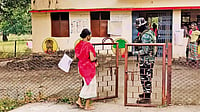In October, Shankar Podiyami, a youth from Bijapur district, was abducted by Maoists when he went to visit his partner, who lives in her native village, tucked deep inside a forest. The Maoists were upset with Podiyami as he had joined Bastar Fighter forces about three months ago.
They have been raising their objections against these newly-formed units of Chhattisgarh police comprising around 2,000 local youths from the seven districts of Bastar division. These youths, who know the forests in the region well and are comfortable with the local language, assist the security forces in tracking down the Maoists.
Almost a week after abducting Podiyami, the Maoists called for a kangaroo court known as Jan Adalat in the deep woods of Bijapur, 1,000 kms from the state capital Raipur, where they were to decide his fate. They invited Podiyami’s family members, journalists, and representatives of the Sarv Adivasi Samaj to be present at the ‘trial’.
The ‘invitees’ arrived first; the Maoist leaders followed. Podiyami was produced before the ‘court’, and one of the cadres spelled out the allegations against the ‘accused’. Maoists believe that security personnel commit atrocities on them while patrolling and Podiyami was seen as a representative of the alternative police force who they believe are unreasonably brutal.
Those present in the ‘court’ believed that Podiyami should be killed. The journalists, representatives of the Sarv Adivasi Samaj and Podiyami’s family members were shaken by this and they decided to defend him. The debate went on. After a four-hour long debate, the Maoists came to the conclusion that Podiyami had recently joined the forces and had not been a part of any patrolling, raid, or encounter yet. They also accepted that he had come to the sensitive village to meet his partner and there was no hidden agenda.
Podiyami’s elder brother pleaded with the public and the Maoists to release him. He assured them that his brother would leave the Bastar Fighter forces. His girlfriend was produced in the ‘court’ as well. She revealed that they both studied in the same residential school and that Podiyami had never committed any crime, and always encouraged her to continue with her higher studies. Representatives of the Sarv Adivasi Samaj, too, requested for his release on humanitarian grounds.
Podiyami was asked to present his defence. He informed the ‘court’ that he worked as a volunteer-teacher —known in the region as shikshadoot— in a primary government school in his native village for years before joining the Bastar Fighter force. “I had to quit my job because sometimes the salary would get credited after months or even a year. I was finding it very difficult to support my family. Joining the Bastar Fighter force was the only viable option. I had no ill-intention against my fellow Adivasis when I joined the force,” said Podiyami.
Finally, a week after his abduction, Podiyami was released. He quit the force and decided to take up farming on his ancestral land for survival.
Podiyami is not the only one. The harassment faced by him highlights the plight of shikshadoots in Sukma and Bijapur districts.
Re-opening Demolished Schools
The educational infrastructure in the sensitive regions of Bastar was demolished by the Maoists during the Salwa Judum conflict — formed in 2005 as a state-sponsored vigilante movement against the Maoists. They alleged that the security forces had occupied school buildings that were serving as detention and torture centres. Several school buildings in present-day Sukma (erstwhile Dantewada) and Bijapur regions were demolished, forcing thousands of children out of the education system.
The district administration had set up temporary residential schools called Pota Cabins to help children continue with their education, but they could not cater to a large number of dropouts.
In 2018, a few educated youths from Sukma region, who returned to their native villages after completing their education, approached the then collector of Sukma, Jay Prakash Maurya, with a proposal to re-open the demolished and closed government schools in the Konta region of Sukma district.
Maurya asked them to conduct a survey of the closed schools and the number of out-of-school children in the highly sensitive Konta region. The requisite data was provided—113 government schools were reported to have been demolished. Maurya asked the youth to get permission from the Maoists to re-open these schools. The youths mobilised the local village bodies and approached the Maoists for permission. The Maoists said that the district administration could re-operate closed schools, Anganwadis and Primary Health Centres in their strongholds on two conditions—these can’t be concrete buildings and outsiders won’t be allowed to work as teachers.
Finally, 93 closed and demolished schools were re-opened in Sukma. These schools were operating from thatched hut structures built with the support of local villagers. High school-passed Adivasi youths from those sensitive villages were appointed as shikshadoots. Around 4,000 out-of-school children were admitted to these schools.
In 2021, replicating the Sukma model, 110 closed schools were re-opened in highly sensitive areas of Bijapur district. Local Adivasi youths like Podiyami were appointed as shikshadoots.
The re-opening of these schools has proved to be a huge step towards political peace-building in the war-torn region. By allowing children to continue schooling, the local Adivasi youths and villagers have brought Maoists and the district administration—two major factions in the ongoing ‘war’—onto the same page.
The Plight of Shikshadoots
However, these shikshadoots, who have played a key role in integrating children back into the education system, are facing multiple challenges. To begin with, the position of these shikshadoots is not a permanent one. The recruitments are haphazard and need-based. There is no job security as their appointments are not official.
In the absence of any official system, they don’t get any benefits like health insurance or compensation in the case of death. This factor is crucial because many of these shikshadoots work in schools that are situated in sensitive Maoist regions where tussles between security forces and the Moaists are common. In June, Kawasi Sukka, a shikshadoot was abducted and brutally murdered by Maoists as they suspected he was a police informer. In 2021, Oiyami Hidma, a shikshadoot who taught at a government school in Bhandar Padhar village died of malaria. In both cases, no proper compensation was provided to their family members and their salaries stopped after their deaths.
These shikshadoots have been organising multiple protest marches and demonstrations for some time now, but their demands are not met.
While on the one hand, the state government is reluctant to ensure proper rights to these shikshadoots, on the other hand, it is creating multiple opportunities for the youths of Bastar to join forces like Bastar Fighters. Adivasi youths like Podiyami, tired of fighting for their rights, are forced to pick up state-sponsored guns, which is making them vulnerable to killing and abduction by Maoists. Despite the protests, the situation on the ground is not changing. For instance, the recent teachers’ recruitment advertisement released by the state had no special quota for Adivasi youths. So, more youths may be forced to join the forces.
The Bigger Picture
Chhattisgarh is among the top three mineral contributors in the country. However, as per a report published by the Oxford Poverty and Human Development Initiative, in collaboration with the United Nations Development Programme (UNDP), it was also among the nine poorest states in the country in 2019-21. According to a NITI Aayog report, 40 per cent of the state’s population lives below the poverty line. As per the 2011 Census, 41 per cent of Adivasis are illiterate—the average literacy rate stands at 70.3 per cent.
These figures draw a direct correlation between the illiteracy rate and the prevalent poverty in the state. The dismal illiteracy rate is restricting the upward mobility of Adivasis on the socio-economic ladder. While the Centre and state governments have formulated various policies to uplift the Adivasis, the situation on the ground is changing at a slower pace.
The Tribal Development Report 2022, released by an independent body set up by the Centre, has revealed that 48.2 per cent of Adivasi children in India drop out of school even before they reach Class 8. The maximum percentage of dropouts has been reported from the elementary classes in Adivasi areas of Chhattisgarh, Jharkhand, Madhya Pradesh, Rajasthan, and Odisha. The report further revealed that 62 per cent of children, mostly from these marked areas, drop out before they reach Class 10. This means only 38 per cent of Adivasi children who had been admitted to the elementary classes complete their secondary education.
Under such circumstances, it becomes imperative for the Centre and state governments to come up with policies and reservations meant for Adivasis, especially in the education and employment sectors, to ensure equitable social justice for these marginalised communities.
How inclusive and supportive are the present schemes and policies implemented by the governments? If we focus on analysing opportunities available to Adivasi youths to work as government school teachers, multiple studies have been conducted on the representation of Adivasis in the staffing of higher education institutions, but studies on the representation of Adivasis as government teachers in states like Chhattisgarh, Jharkhand or Odisha are rare to find. This when 78 per cent of Adivasi children in the country study in government schools.
The National Education Policy (2020) document quotes: “By 2030, the minimum degree qualification for teaching will be a four-year integrated BEd degree.” Can this NEP provision be implemented uniformly across the country? If yes, will it not hinder Adivasis from being a part of the state government teachers’ force?
At present, a diploma in Elementary Education—a two-year diploma-level course that can be pursued after Class 12 and is focused on child education—is the minimum qualification for being selected as a government teacher. Upgrading the minimum qualification will minimise the chances of Adivasi youths getting into teaching.
In Chhattisgarh, only 6 per cent of Adivasis are graduates. This indicates that the percentage of graduate Adivasis in India is marginal. This statement is further substantiated by the fact that not enough applications from Adivasi candidates are received against the reserved posts in higher education institutes.
The rampant illiteracy rates amongst Adivasis in India can be directly attributed to the poor economic conditions they have been living in. Under such circumstances, a blanket policy like NEP devoid of special provisions and relaxations for the marginalised and trying to implement it without any Adivasi-friendly economic policy in those areas will hinder the chances of Adivasis’ upward mobility on the socio-economic ladder.
As the government overlooks these nuances of NEP or other such policies across the country, the challenges faced by Adivasis due to blanket implementation are only mounting. In such a situation, Podiyami and his friends in Bastar will keep choosing state-sponsored guns over teaching jobs to be further harassed or killed by the Maoists.
(This appeared in print as ‘Teaching Troubles’)
Prasun Goswami is a Campaigner for Disarmed schools and safe childhoods in war zones
Raunak Shivhare is an independent journalist based in Chhattisgarh


























